A Comparative Study: Microsoft Teams vs. Google Classroom in Education
VerifiedAdded on 2022/10/09
|11
|2635
|15
Report
AI Summary
This report provides a comparative analysis of Microsoft Teams and Google Classroom, two prominent learning platforms. The study explores the methodologies used to evaluate these platforms, including literature searches and database resources. The report highlights the features of each platform, such as Google Classroom's integration with Google Drive and Microsoft Teams' chat and scheduling functionalities. The report discusses the trends in both platforms, including their evolution and the addition of new features. The findings suggest that both platforms offer advantages, with Google Classroom being user-friendly and Microsoft Teams offering a more comprehensive layout and features. The report concludes that both platforms are effective in enhancing the learning process, emphasizing the need for further research and rigorous testing of these learning tools. The report also explores the historical context, features, assignments, and ranking schemes of Google Classroom, as well as the advantages and disadvantages of both systems. The study uses peer-reviewed journal articles, conference papers, and business system research to compare the two platforms.
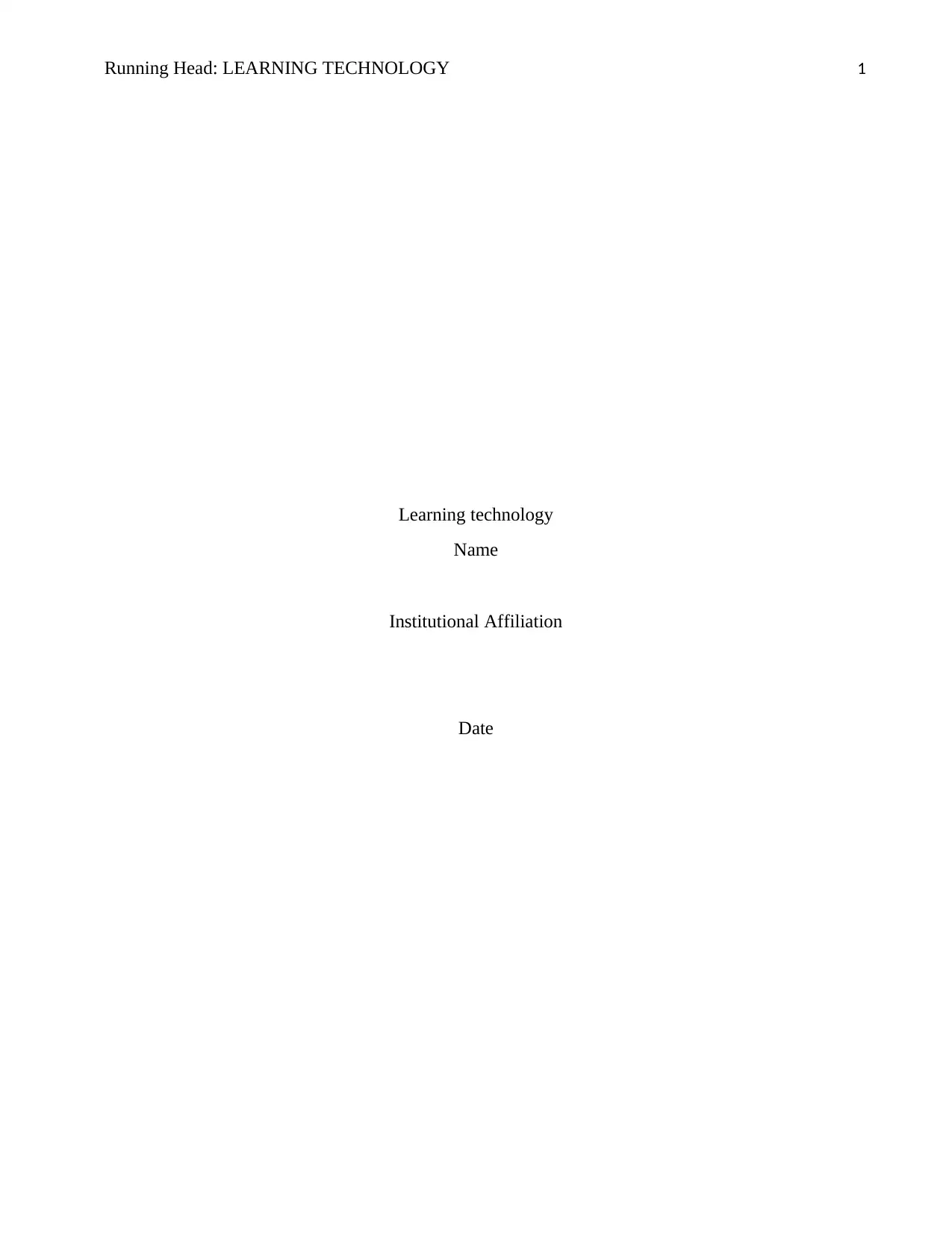
Running Head: LEARNING TECHNOLOGY 1
Learning technology
Name
Institutional Affiliation
Date
Learning technology
Name
Institutional Affiliation
Date
Secure Best Marks with AI Grader
Need help grading? Try our AI Grader for instant feedback on your assignments.
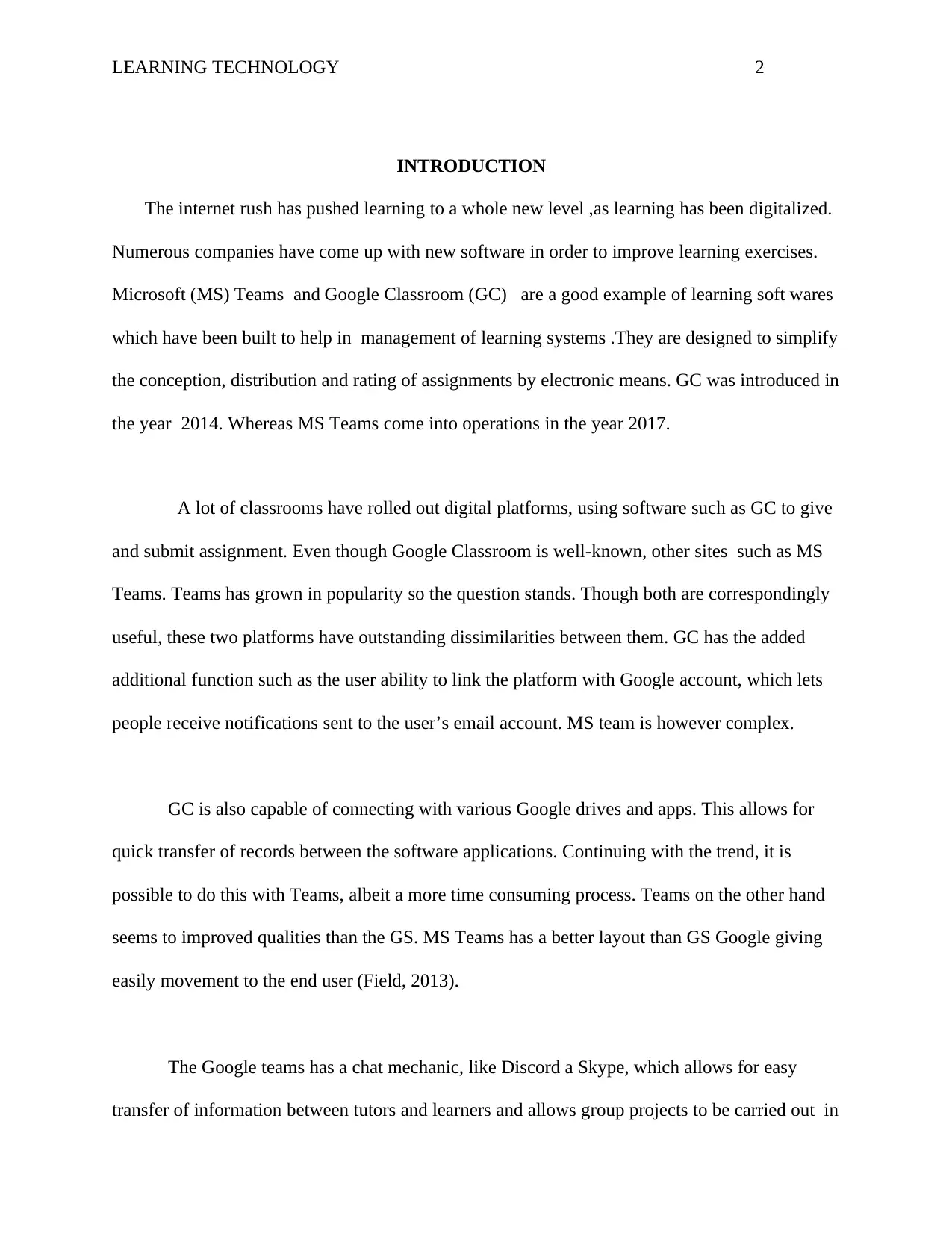
LEARNING TECHNOLOGY 2
INTRODUCTION
The internet rush has pushed learning to a whole new level ,as learning has been digitalized.
Numerous companies have come up with new software in order to improve learning exercises.
Microsoft (MS) Teams and Google Classroom (GC) are a good example of learning soft wares
which have been built to help in management of learning systems .They are designed to simplify
the conception, distribution and rating of assignments by electronic means. GC was introduced in
the year 2014. Whereas MS Teams come into operations in the year 2017.
A lot of classrooms have rolled out digital platforms, using software such as GC to give
and submit assignment. Even though Google Classroom is well-known, other sites such as MS
Teams. Teams has grown in popularity so the question stands. Though both are correspondingly
useful, these two platforms have outstanding dissimilarities between them. GC has the added
additional function such as the user ability to link the platform with Google account, which lets
people receive notifications sent to the user’s email account. MS team is however complex.
GC is also capable of connecting with various Google drives and apps. This allows for
quick transfer of records between the software applications. Continuing with the trend, it is
possible to do this with Teams, albeit a more time consuming process. Teams on the other hand
seems to improved qualities than the GS. MS Teams has a better layout than GS Google giving
easily movement to the end user (Field, 2013).
The Google teams has a chat mechanic, like Discord a Skype, which allows for easy
transfer of information between tutors and learners and allows group projects to be carried out in
INTRODUCTION
The internet rush has pushed learning to a whole new level ,as learning has been digitalized.
Numerous companies have come up with new software in order to improve learning exercises.
Microsoft (MS) Teams and Google Classroom (GC) are a good example of learning soft wares
which have been built to help in management of learning systems .They are designed to simplify
the conception, distribution and rating of assignments by electronic means. GC was introduced in
the year 2014. Whereas MS Teams come into operations in the year 2017.
A lot of classrooms have rolled out digital platforms, using software such as GC to give
and submit assignment. Even though Google Classroom is well-known, other sites such as MS
Teams. Teams has grown in popularity so the question stands. Though both are correspondingly
useful, these two platforms have outstanding dissimilarities between them. GC has the added
additional function such as the user ability to link the platform with Google account, which lets
people receive notifications sent to the user’s email account. MS team is however complex.
GC is also capable of connecting with various Google drives and apps. This allows for
quick transfer of records between the software applications. Continuing with the trend, it is
possible to do this with Teams, albeit a more time consuming process. Teams on the other hand
seems to improved qualities than the GS. MS Teams has a better layout than GS Google giving
easily movement to the end user (Field, 2013).
The Google teams has a chat mechanic, like Discord a Skype, which allows for easy
transfer of information between tutors and learners and allows group projects to be carried out in
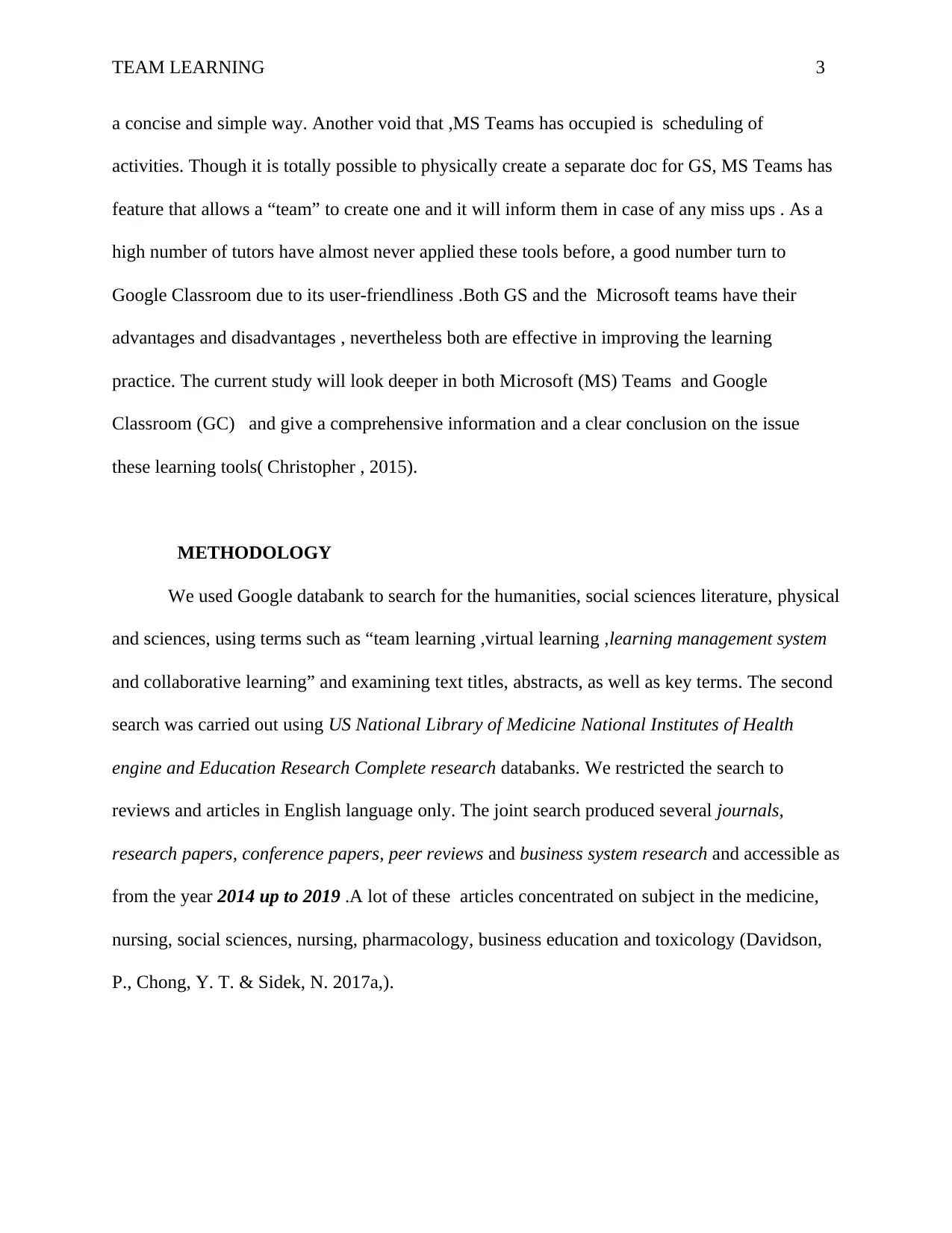
TEAM LEARNING 3
a concise and simple way. Another void that ,MS Teams has occupied is scheduling of
activities. Though it is totally possible to physically create a separate doc for GS, MS Teams has
feature that allows a “team” to create one and it will inform them in case of any miss ups . As a
high number of tutors have almost never applied these tools before, a good number turn to
Google Classroom due to its user-friendliness .Both GS and the Microsoft teams have their
advantages and disadvantages , nevertheless both are effective in improving the learning
practice. The current study will look deeper in both Microsoft (MS) Teams and Google
Classroom (GC) and give a comprehensive information and a clear conclusion on the issue
these learning tools( Christopher , 2015).
METHODOLOGY
We used Google databank to search for the humanities, social sciences literature, physical
and sciences, using terms such as “team learning ,virtual learning ,learning management system
and collaborative learning” and examining text titles, abstracts, as well as key terms. The second
search was carried out using US National Library of Medicine National Institutes of Health
engine and Education Research Complete research databanks. We restricted the search to
reviews and articles in English language only. The joint search produced several journals,
research papers, conference papers, peer reviews and business system research and accessible as
from the year 2014 up to 2019 .A lot of these articles concentrated on subject in the medicine,
nursing, social sciences, nursing, pharmacology, business education and toxicology (Davidson,
P., Chong, Y. T. & Sidek, N. 2017a,).
a concise and simple way. Another void that ,MS Teams has occupied is scheduling of
activities. Though it is totally possible to physically create a separate doc for GS, MS Teams has
feature that allows a “team” to create one and it will inform them in case of any miss ups . As a
high number of tutors have almost never applied these tools before, a good number turn to
Google Classroom due to its user-friendliness .Both GS and the Microsoft teams have their
advantages and disadvantages , nevertheless both are effective in improving the learning
practice. The current study will look deeper in both Microsoft (MS) Teams and Google
Classroom (GC) and give a comprehensive information and a clear conclusion on the issue
these learning tools( Christopher , 2015).
METHODOLOGY
We used Google databank to search for the humanities, social sciences literature, physical
and sciences, using terms such as “team learning ,virtual learning ,learning management system
and collaborative learning” and examining text titles, abstracts, as well as key terms. The second
search was carried out using US National Library of Medicine National Institutes of Health
engine and Education Research Complete research databanks. We restricted the search to
reviews and articles in English language only. The joint search produced several journals,
research papers, conference papers, peer reviews and business system research and accessible as
from the year 2014 up to 2019 .A lot of these articles concentrated on subject in the medicine,
nursing, social sciences, nursing, pharmacology, business education and toxicology (Davidson,
P., Chong, Y. T. & Sidek, N. 2017a,).
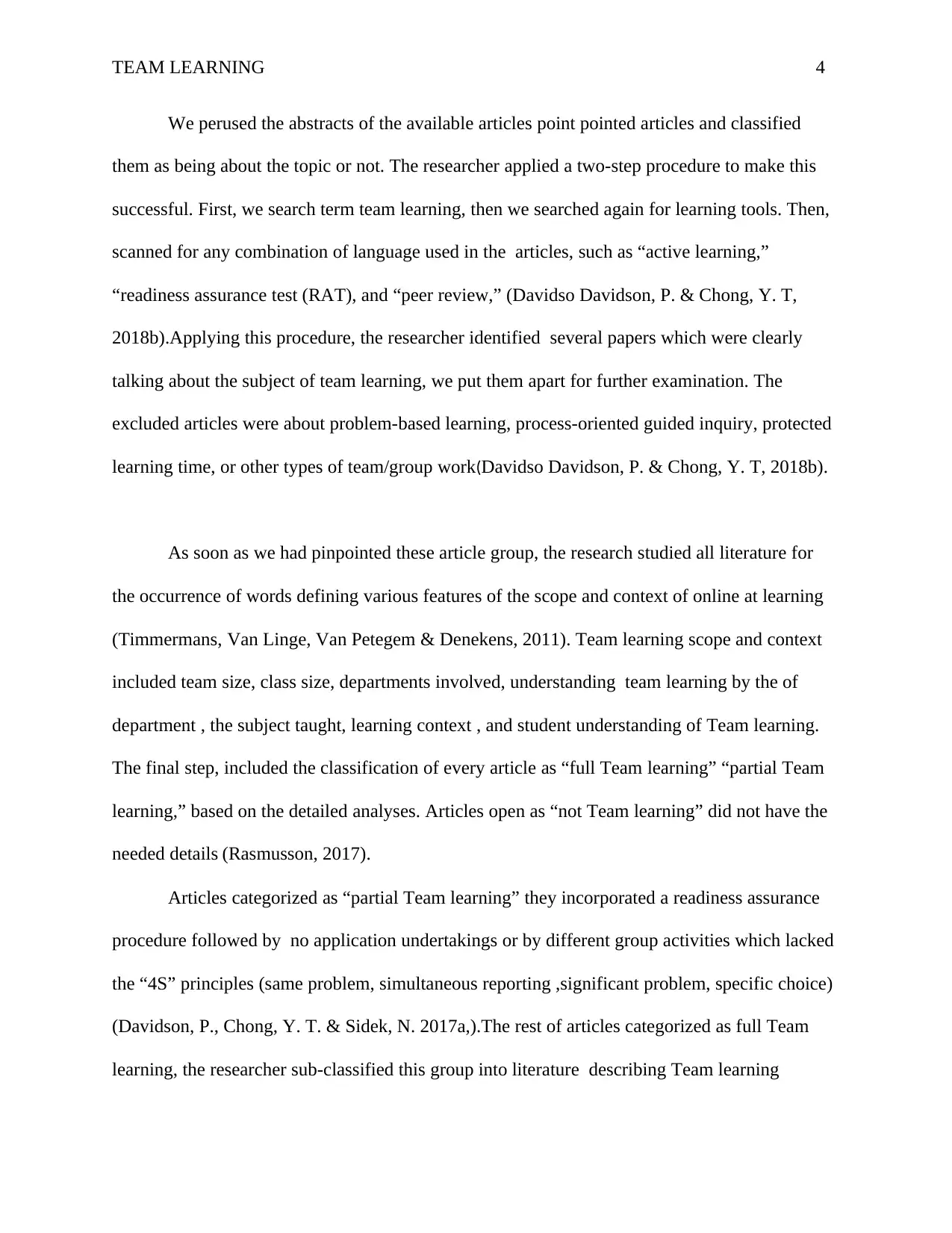
TEAM LEARNING 4
We perused the abstracts of the available articles point pointed articles and classified
them as being about the topic or not. The researcher applied a two-step procedure to make this
successful. First, we search term team learning, then we searched again for learning tools. Then,
scanned for any combination of language used in the articles, such as “active learning,”
“readiness assurance test (RAT), and “peer review,” (Davidso Davidson, P. & Chong, Y. T,
2018b).Applying this procedure, the researcher identified several papers which were clearly
talking about the subject of team learning, we put them apart for further examination. The
excluded articles were about problem-based learning, process-oriented guided inquiry, protected
learning time, or other types of team/group work(Davidso Davidson, P. & Chong, Y. T, 2018b).
As soon as we had pinpointed these article group, the research studied all literature for
the occurrence of words defining various features of the scope and context of online at learning
(Timmermans, Van Linge, Van Petegem & Denekens, 2011). Team learning scope and context
included team size, class size, departments involved, understanding team learning by the of
department , the subject taught, learning context , and student understanding of Team learning.
The final step, included the classification of every article as “full Team learning” “partial Team
learning,” based on the detailed analyses. Articles open as “not Team learning” did not have the
needed details (Rasmusson, 2017).
Articles categorized as “partial Team learning” they incorporated a readiness assurance
procedure followed by no application undertakings or by different group activities which lacked
the “4S” principles (same problem, simultaneous reporting ,significant problem, specific choice)
(Davidson, P., Chong, Y. T. & Sidek, N. 2017a,).The rest of articles categorized as full Team
learning, the researcher sub-classified this group into literature describing Team learning
We perused the abstracts of the available articles point pointed articles and classified
them as being about the topic or not. The researcher applied a two-step procedure to make this
successful. First, we search term team learning, then we searched again for learning tools. Then,
scanned for any combination of language used in the articles, such as “active learning,”
“readiness assurance test (RAT), and “peer review,” (Davidso Davidson, P. & Chong, Y. T,
2018b).Applying this procedure, the researcher identified several papers which were clearly
talking about the subject of team learning, we put them apart for further examination. The
excluded articles were about problem-based learning, process-oriented guided inquiry, protected
learning time, or other types of team/group work(Davidso Davidson, P. & Chong, Y. T, 2018b).
As soon as we had pinpointed these article group, the research studied all literature for
the occurrence of words defining various features of the scope and context of online at learning
(Timmermans, Van Linge, Van Petegem & Denekens, 2011). Team learning scope and context
included team size, class size, departments involved, understanding team learning by the of
department , the subject taught, learning context , and student understanding of Team learning.
The final step, included the classification of every article as “full Team learning” “partial Team
learning,” based on the detailed analyses. Articles open as “not Team learning” did not have the
needed details (Rasmusson, 2017).
Articles categorized as “partial Team learning” they incorporated a readiness assurance
procedure followed by no application undertakings or by different group activities which lacked
the “4S” principles (same problem, simultaneous reporting ,significant problem, specific choice)
(Davidson, P., Chong, Y. T. & Sidek, N. 2017a,).The rest of articles categorized as full Team
learning, the researcher sub-classified this group into literature describing Team learning
Secure Best Marks with AI Grader
Need help grading? Try our AI Grader for instant feedback on your assignments.
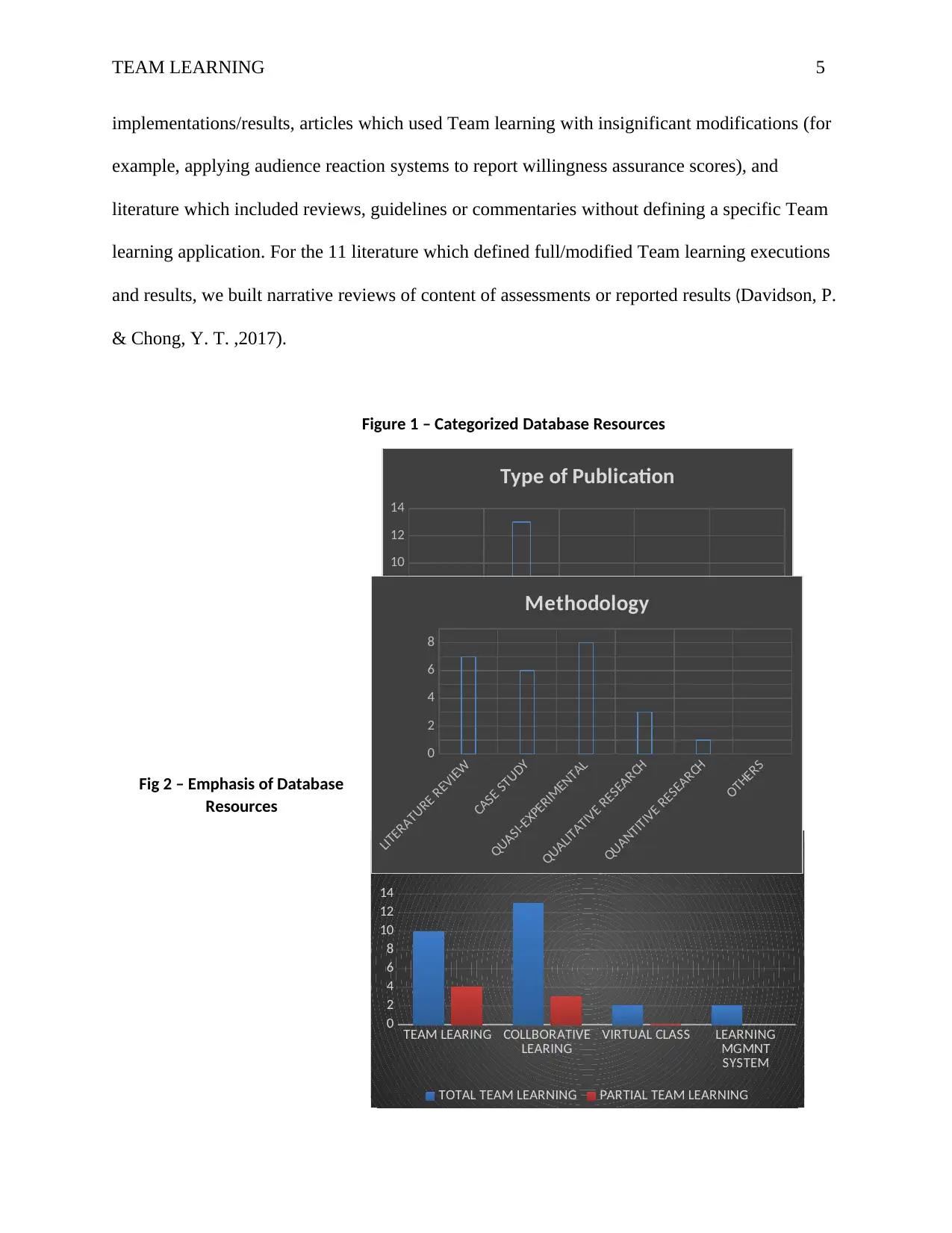
TEAM LEARNING 5
implementations/results, articles which used Team learning with insignificant modifications (for
example, applying audience reaction systems to report willingness assurance scores), and
literature which included reviews, guidelines or commentaries without defining a specific Team
learning application. For the 11 literature which defined full/modified Team learning executions
and results, we built narrative reviews of content of assessments or reported results (Davidson, P.
& Chong, Y. T. ,2017).
Figure 1 – Categorized Database Resources
Fig 2 – Emphasis of Database
Resources
Peer Review Journal Research Conference Business
system
research
0
2
4
6
8
10
12
14
Type of Publication
TEAM LEARING COLLBORATIVE
LEARING VIRTUAL CLASS LEARNING
MGMNT
SYSTEM
0
2
4
6
8
10
12
14
Focus of Database Resources
TOTAL TEAM LEARNING PARTIAL TEAM LEARNING
LITERATURE REVIEW
CASE STUDY
QUASI-EXPERIMENTAL
QUALITATIVE RESEARCH
QUANTITIVE RESEARCH
OTHERS
0
2
4
6
8
Methodology
implementations/results, articles which used Team learning with insignificant modifications (for
example, applying audience reaction systems to report willingness assurance scores), and
literature which included reviews, guidelines or commentaries without defining a specific Team
learning application. For the 11 literature which defined full/modified Team learning executions
and results, we built narrative reviews of content of assessments or reported results (Davidson, P.
& Chong, Y. T. ,2017).
Figure 1 – Categorized Database Resources
Fig 2 – Emphasis of Database
Resources
Peer Review Journal Research Conference Business
system
research
0
2
4
6
8
10
12
14
Type of Publication
TEAM LEARING COLLBORATIVE
LEARING VIRTUAL CLASS LEARNING
MGMNT
SYSTEM
0
2
4
6
8
10
12
14
Focus of Database Resources
TOTAL TEAM LEARNING PARTIAL TEAM LEARNING
LITERATURE REVIEW
CASE STUDY
QUASI-EXPERIMENTAL
QUALITATIVE RESEARCH
QUANTITIVE RESEARCH
OTHERS
0
2
4
6
8
Methodology
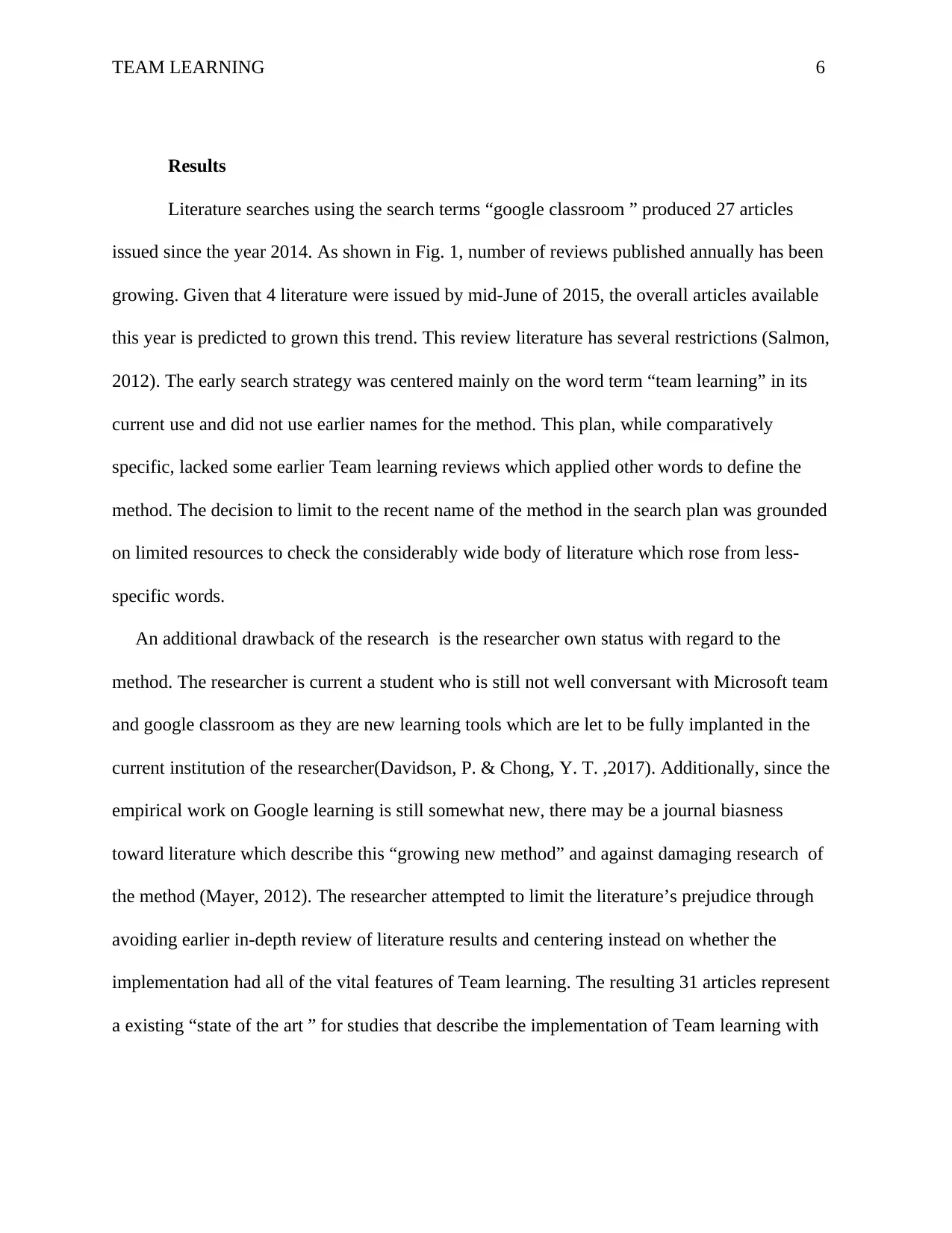
TEAM LEARNING 6
Results
Literature searches using the search terms “google classroom ” produced 27 articles
issued since the year 2014. As shown in Fig. 1, number of reviews published annually has been
growing. Given that 4 literature were issued by mid-June of 2015, the overall articles available
this year is predicted to grown this trend. This review literature has several restrictions (Salmon,
2012). The early search strategy was centered mainly on the word term “team learning” in its
current use and did not use earlier names for the method. This plan, while comparatively
specific, lacked some earlier Team learning reviews which applied other words to define the
method. The decision to limit to the recent name of the method in the search plan was grounded
on limited resources to check the considerably wide body of literature which rose from less-
specific words.
An additional drawback of the research is the researcher own status with regard to the
method. The researcher is current a student who is still not well conversant with Microsoft team
and google classroom as they are new learning tools which are let to be fully implanted in the
current institution of the researcher(Davidson, P. & Chong, Y. T. ,2017). Additionally, since the
empirical work on Google learning is still somewhat new, there may be a journal biasness
toward literature which describe this “growing new method” and against damaging research of
the method (Mayer, 2012). The researcher attempted to limit the literature’s prejudice through
avoiding earlier in-depth review of literature results and centering instead on whether the
implementation had all of the vital features of Team learning. The resulting 31 articles represent
a existing “state of the art ” for studies that describe the implementation of Team learning with
Results
Literature searches using the search terms “google classroom ” produced 27 articles
issued since the year 2014. As shown in Fig. 1, number of reviews published annually has been
growing. Given that 4 literature were issued by mid-June of 2015, the overall articles available
this year is predicted to grown this trend. This review literature has several restrictions (Salmon,
2012). The early search strategy was centered mainly on the word term “team learning” in its
current use and did not use earlier names for the method. This plan, while comparatively
specific, lacked some earlier Team learning reviews which applied other words to define the
method. The decision to limit to the recent name of the method in the search plan was grounded
on limited resources to check the considerably wide body of literature which rose from less-
specific words.
An additional drawback of the research is the researcher own status with regard to the
method. The researcher is current a student who is still not well conversant with Microsoft team
and google classroom as they are new learning tools which are let to be fully implanted in the
current institution of the researcher(Davidson, P. & Chong, Y. T. ,2017). Additionally, since the
empirical work on Google learning is still somewhat new, there may be a journal biasness
toward literature which describe this “growing new method” and against damaging research of
the method (Mayer, 2012). The researcher attempted to limit the literature’s prejudice through
avoiding earlier in-depth review of literature results and centering instead on whether the
implementation had all of the vital features of Team learning. The resulting 31 articles represent
a existing “state of the art ” for studies that describe the implementation of Team learning with
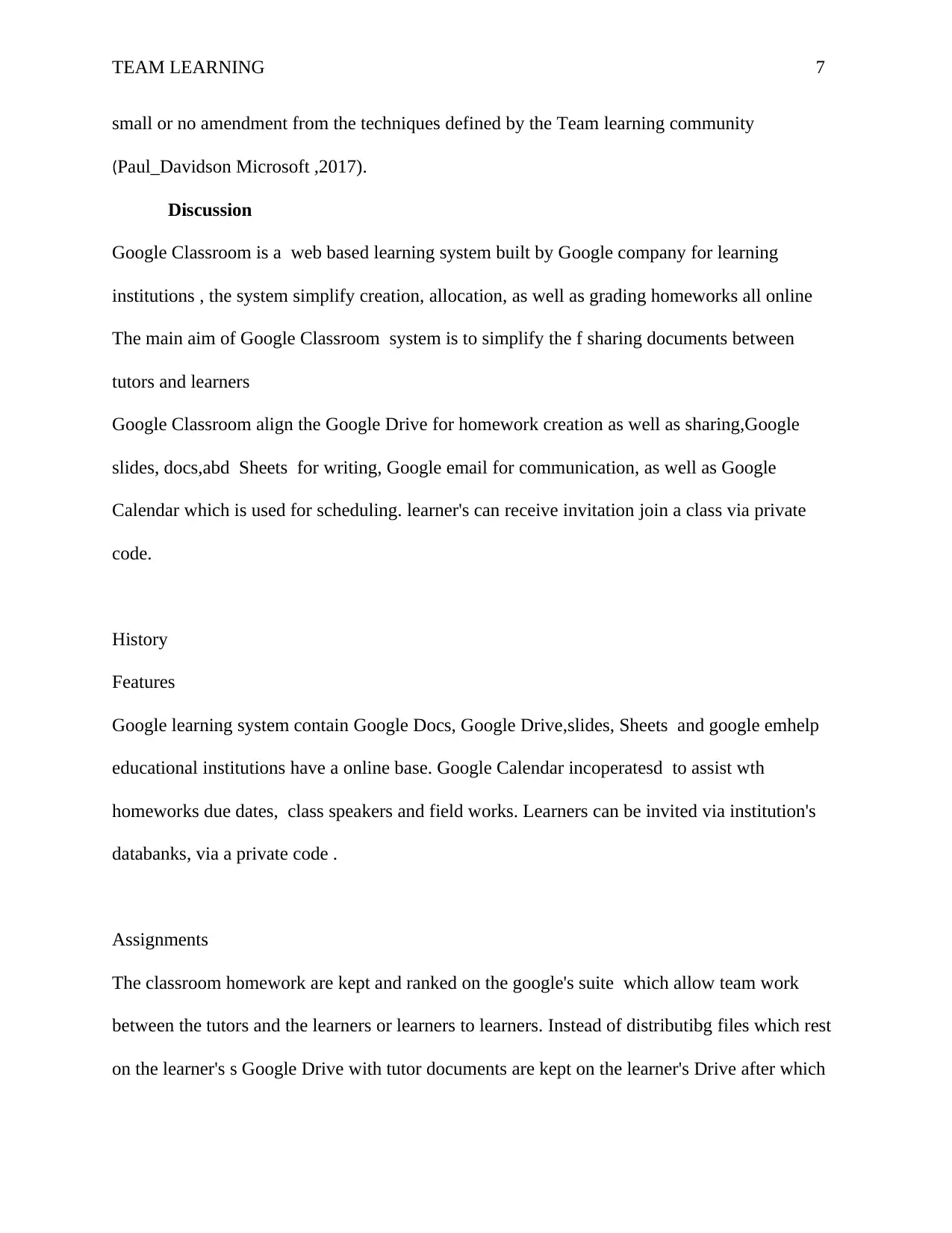
TEAM LEARNING 7
small or no amendment from the techniques defined by the Team learning community
(Paul_Davidson Microsoft ,2017).
Discussion
Google Classroom is a web based learning system built by Google company for learning
institutions , the system simplify creation, allocation, as well as grading homeworks all online
The main aim of Google Classroom system is to simplify the f sharing documents between
tutors and learners
Google Classroom align the Google Drive for homework creation as well as sharing,Google
slides, docs,abd Sheets for writing, Google email for communication, as well as Google
Calendar which is used for scheduling. learner's can receive invitation join a class via private
code.
History
Features
Google learning system contain Google Docs, Google Drive,slides, Sheets and google emhelp
educational institutions have a online base. Google Calendar incoperatesd to assist wth
homeworks due dates, class speakers and field works. Learners can be invited via institution's
databanks, via a private code .
Assignments
The classroom homework are kept and ranked on the google's suite which allow team work
between the tutors and the learners or learners to learners. Instead of distributibg files which rest
on the learner's s Google Drive with tutor documents are kept on the learner's Drive after which
small or no amendment from the techniques defined by the Team learning community
(Paul_Davidson Microsoft ,2017).
Discussion
Google Classroom is a web based learning system built by Google company for learning
institutions , the system simplify creation, allocation, as well as grading homeworks all online
The main aim of Google Classroom system is to simplify the f sharing documents between
tutors and learners
Google Classroom align the Google Drive for homework creation as well as sharing,Google
slides, docs,abd Sheets for writing, Google email for communication, as well as Google
Calendar which is used for scheduling. learner's can receive invitation join a class via private
code.
History
Features
Google learning system contain Google Docs, Google Drive,slides, Sheets and google emhelp
educational institutions have a online base. Google Calendar incoperatesd to assist wth
homeworks due dates, class speakers and field works. Learners can be invited via institution's
databanks, via a private code .
Assignments
The classroom homework are kept and ranked on the google's suite which allow team work
between the tutors and the learners or learners to learners. Instead of distributibg files which rest
on the learner's s Google Drive with tutor documents are kept on the learner's Drive after which
Paraphrase This Document
Need a fresh take? Get an instant paraphrase of this document with our AI Paraphraser
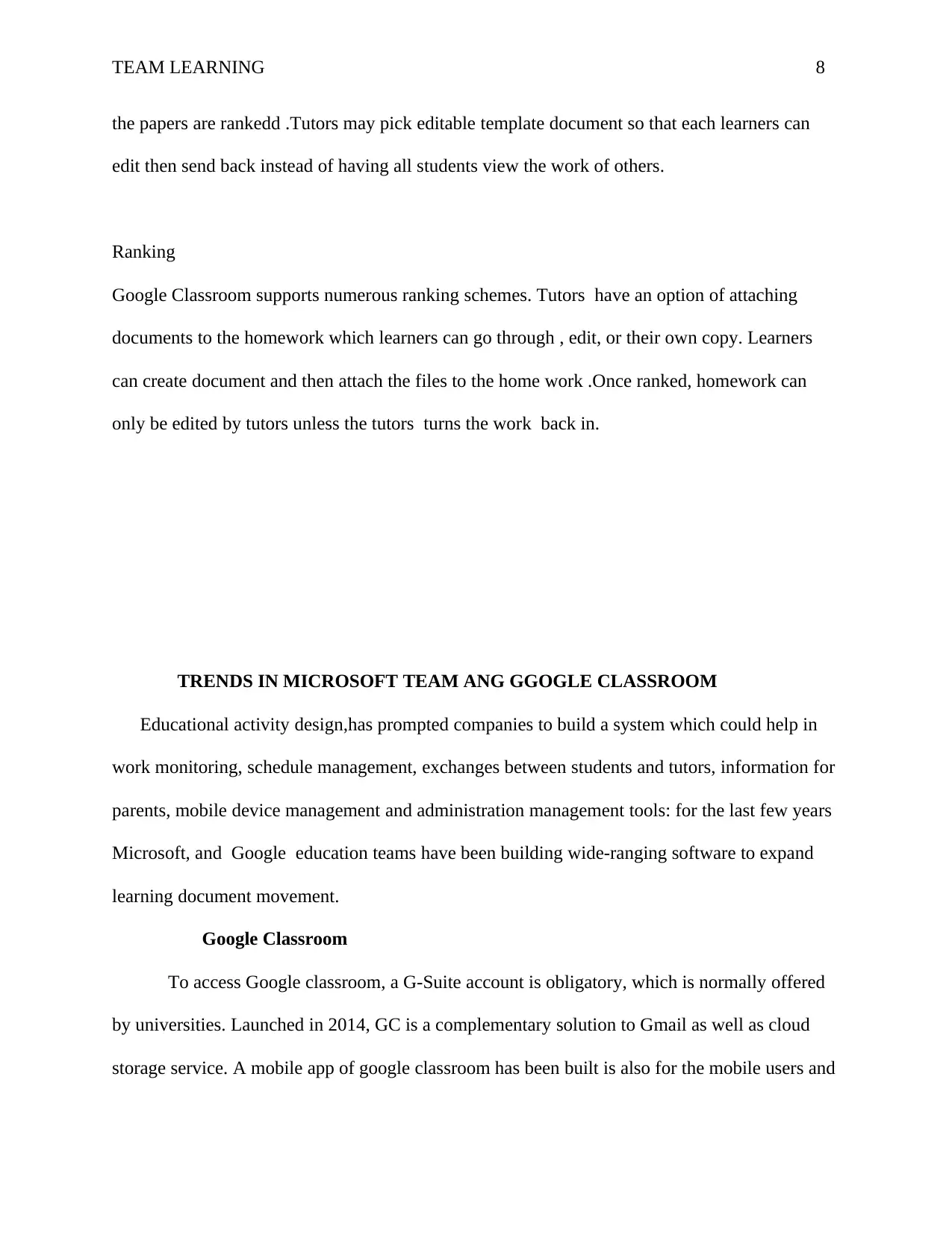
TEAM LEARNING 8
the papers are rankedd .Tutors may pick editable template document so that each learners can
edit then send back instead of having all students view the work of others.
Ranking
Google Classroom supports numerous ranking schemes. Tutors have an option of attaching
documents to the homework which learners can go through , edit, or their own copy. Learners
can create document and then attach the files to the home work .Once ranked, homework can
only be edited by tutors unless the tutors turns the work back in.
TRENDS IN MICROSOFT TEAM ANG GGOGLE CLASSROOM
Educational activity design,has prompted companies to build a system which could help in
work monitoring, schedule management, exchanges between students and tutors, information for
parents, mobile device management and administration management tools: for the last few years
Microsoft, and Google education teams have been building wide-ranging software to expand
learning document movement.
Google Classroom
To access Google classroom, a G-Suite account is obligatory, which is normally offered
by universities. Launched in 2014, GC is a complementary solution to Gmail as well as cloud
storage service. A mobile app of google classroom has been built is also for the mobile users and
the papers are rankedd .Tutors may pick editable template document so that each learners can
edit then send back instead of having all students view the work of others.
Ranking
Google Classroom supports numerous ranking schemes. Tutors have an option of attaching
documents to the homework which learners can go through , edit, or their own copy. Learners
can create document and then attach the files to the home work .Once ranked, homework can
only be edited by tutors unless the tutors turns the work back in.
TRENDS IN MICROSOFT TEAM ANG GGOGLE CLASSROOM
Educational activity design,has prompted companies to build a system which could help in
work monitoring, schedule management, exchanges between students and tutors, information for
parents, mobile device management and administration management tools: for the last few years
Microsoft, and Google education teams have been building wide-ranging software to expand
learning document movement.
Google Classroom
To access Google classroom, a G-Suite account is obligatory, which is normally offered
by universities. Launched in 2014, GC is a complementary solution to Gmail as well as cloud
storage service. A mobile app of google classroom has been built is also for the mobile users and
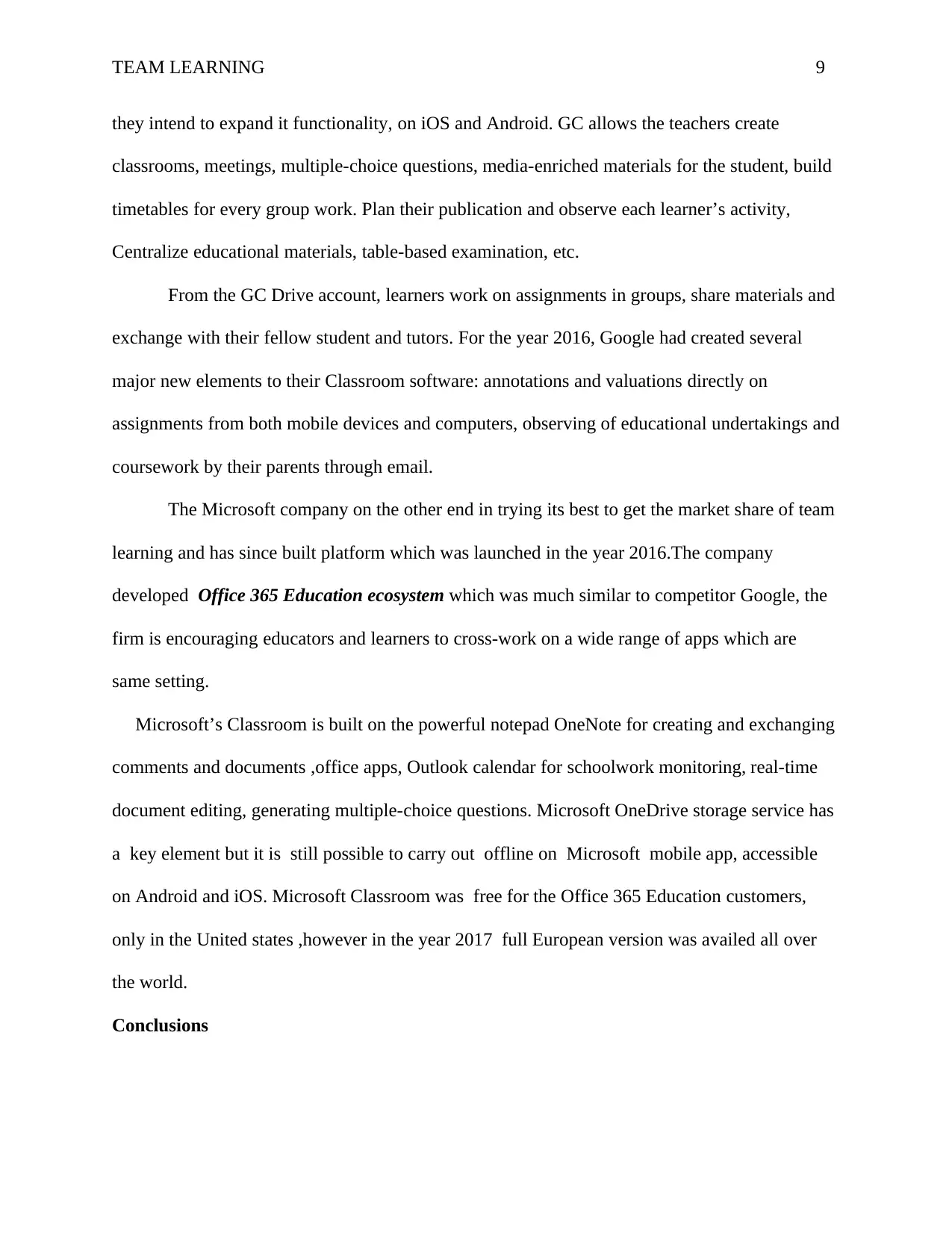
TEAM LEARNING 9
they intend to expand it functionality, on iOS and Android. GC allows the teachers create
classrooms, meetings, multiple-choice questions, media-enriched materials for the student, build
timetables for every group work. Plan their publication and observe each learner’s activity,
Centralize educational materials, table-based examination, etc.
From the GC Drive account, learners work on assignments in groups, share materials and
exchange with their fellow student and tutors. For the year 2016, Google had created several
major new elements to their Classroom software: annotations and valuations directly on
assignments from both mobile devices and computers, observing of educational undertakings and
coursework by their parents through email.
The Microsoft company on the other end in trying its best to get the market share of team
learning and has since built platform which was launched in the year 2016.The company
developed Office 365 Education ecosystem which was much similar to competitor Google, the
firm is encouraging educators and learners to cross-work on a wide range of apps which are
same setting.
Microsoft’s Classroom is built on the powerful notepad OneNote for creating and exchanging
comments and documents ,office apps, Outlook calendar for schoolwork monitoring, real-time
document editing, generating multiple-choice questions. Microsoft OneDrive storage service has
a key element but it is still possible to carry out offline on Microsoft mobile app, accessible
on Android and iOS. Microsoft Classroom was free for the Office 365 Education customers,
only in the United states ,however in the year 2017 full European version was availed all over
the world.
Conclusions
they intend to expand it functionality, on iOS and Android. GC allows the teachers create
classrooms, meetings, multiple-choice questions, media-enriched materials for the student, build
timetables for every group work. Plan their publication and observe each learner’s activity,
Centralize educational materials, table-based examination, etc.
From the GC Drive account, learners work on assignments in groups, share materials and
exchange with their fellow student and tutors. For the year 2016, Google had created several
major new elements to their Classroom software: annotations and valuations directly on
assignments from both mobile devices and computers, observing of educational undertakings and
coursework by their parents through email.
The Microsoft company on the other end in trying its best to get the market share of team
learning and has since built platform which was launched in the year 2016.The company
developed Office 365 Education ecosystem which was much similar to competitor Google, the
firm is encouraging educators and learners to cross-work on a wide range of apps which are
same setting.
Microsoft’s Classroom is built on the powerful notepad OneNote for creating and exchanging
comments and documents ,office apps, Outlook calendar for schoolwork monitoring, real-time
document editing, generating multiple-choice questions. Microsoft OneDrive storage service has
a key element but it is still possible to carry out offline on Microsoft mobile app, accessible
on Android and iOS. Microsoft Classroom was free for the Office 365 Education customers,
only in the United states ,however in the year 2017 full European version was availed all over
the world.
Conclusions
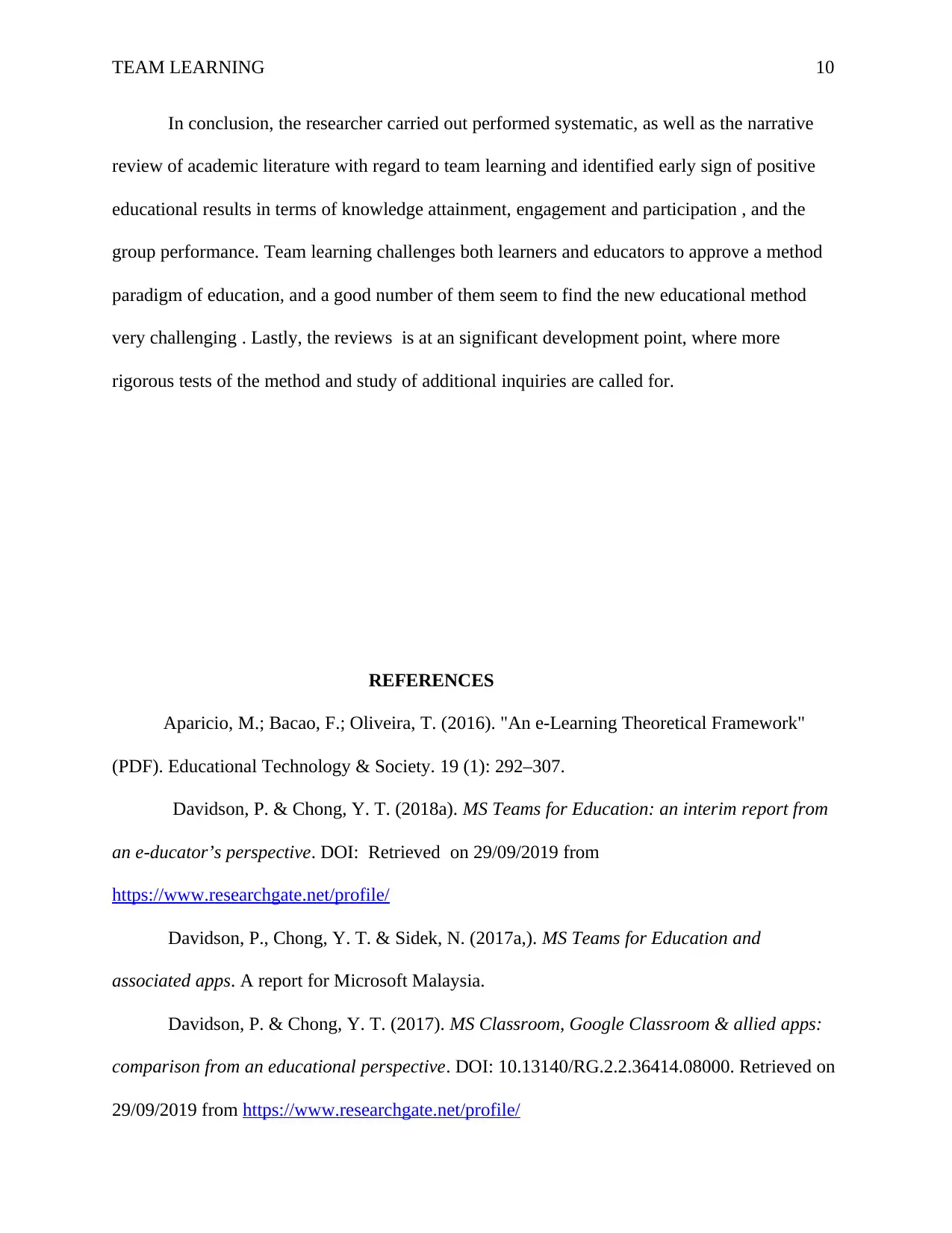
TEAM LEARNING 10
In conclusion, the researcher carried out performed systematic, as well as the narrative
review of academic literature with regard to team learning and identified early sign of positive
educational results in terms of knowledge attainment, engagement and participation , and the
group performance. Team learning challenges both learners and educators to approve a method
paradigm of education, and a good number of them seem to find the new educational method
very challenging . Lastly, the reviews is at an significant development point, where more
rigorous tests of the method and study of additional inquiries are called for.
REFERENCES
Aparicio, M.; Bacao, F.; Oliveira, T. (2016). "An e-Learning Theoretical Framework"
(PDF). Educational Technology & Society. 19 (1): 292–307.
Davidson, P. & Chong, Y. T. (2018a). MS Teams for Education: an interim report from
an e-ducator’s perspective. DOI: Retrieved on 29/09/2019 from
https://www.researchgate.net/profile/
Davidson, P., Chong, Y. T. & Sidek, N. (2017a,). MS Teams for Education and
associated apps. A report for Microsoft Malaysia.
Davidson, P. & Chong, Y. T. (2017). MS Classroom, Google Classroom & allied apps:
comparison from an educational perspective. DOI: 10.13140/RG.2.2.36414.08000. Retrieved on
29/09/2019 from https://www.researchgate.net/profile/
In conclusion, the researcher carried out performed systematic, as well as the narrative
review of academic literature with regard to team learning and identified early sign of positive
educational results in terms of knowledge attainment, engagement and participation , and the
group performance. Team learning challenges both learners and educators to approve a method
paradigm of education, and a good number of them seem to find the new educational method
very challenging . Lastly, the reviews is at an significant development point, where more
rigorous tests of the method and study of additional inquiries are called for.
REFERENCES
Aparicio, M.; Bacao, F.; Oliveira, T. (2016). "An e-Learning Theoretical Framework"
(PDF). Educational Technology & Society. 19 (1): 292–307.
Davidson, P. & Chong, Y. T. (2018a). MS Teams for Education: an interim report from
an e-ducator’s perspective. DOI: Retrieved on 29/09/2019 from
https://www.researchgate.net/profile/
Davidson, P., Chong, Y. T. & Sidek, N. (2017a,). MS Teams for Education and
associated apps. A report for Microsoft Malaysia.
Davidson, P. & Chong, Y. T. (2017). MS Classroom, Google Classroom & allied apps:
comparison from an educational perspective. DOI: 10.13140/RG.2.2.36414.08000. Retrieved on
29/09/2019 from https://www.researchgate.net/profile/
Secure Best Marks with AI Grader
Need help grading? Try our AI Grader for instant feedback on your assignments.
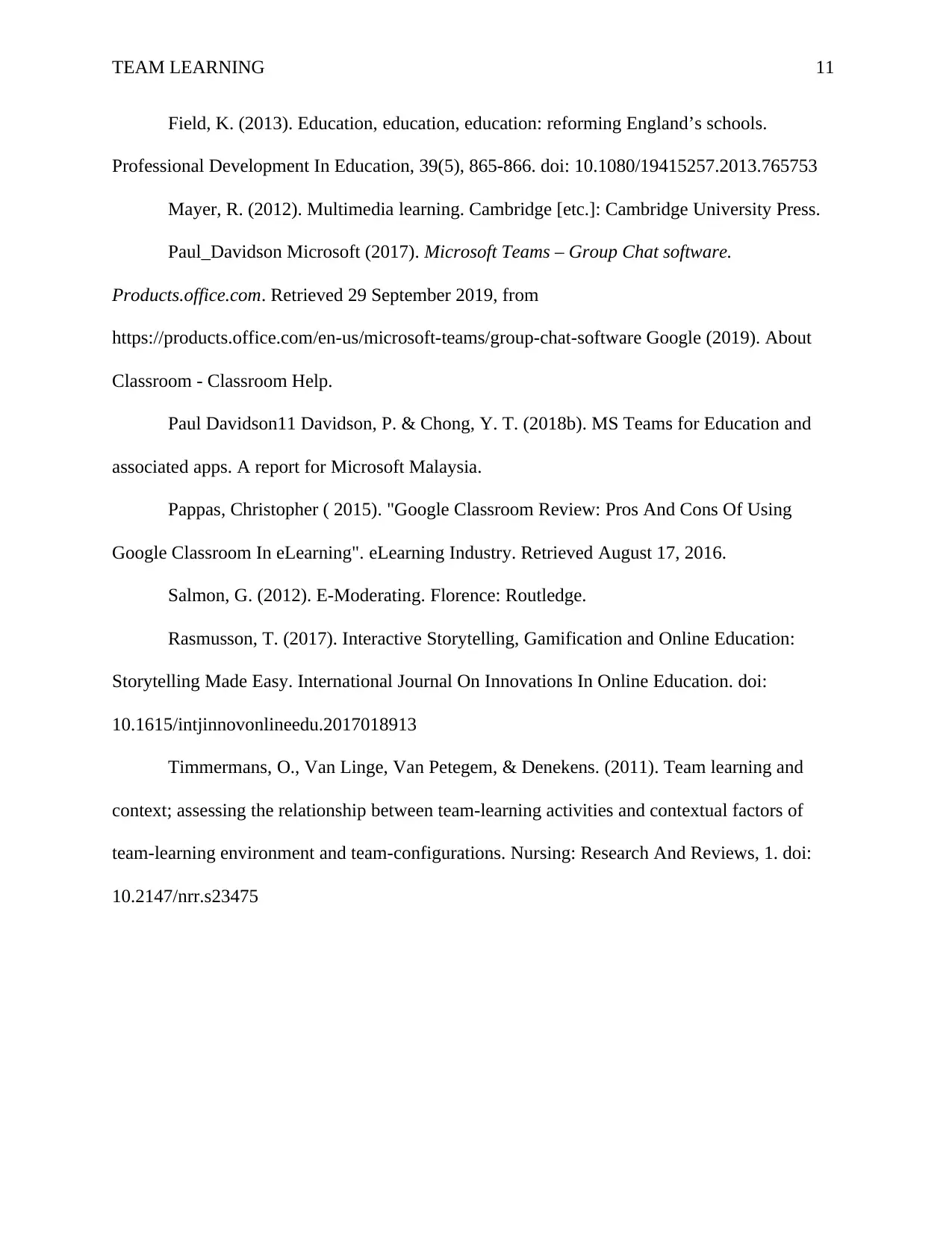
TEAM LEARNING 11
Field, K. (2013). Education, education, education: reforming England’s schools.
Professional Development In Education, 39(5), 865-866. doi: 10.1080/19415257.2013.765753
Mayer, R. (2012). Multimedia learning. Cambridge [etc.]: Cambridge University Press.
Paul_Davidson Microsoft (2017). Microsoft Teams – Group Chat software.
Products.office.com. Retrieved 29 September 2019, from
https://products.office.com/en-us/microsoft-teams/group-chat-software Google (2019). About
Classroom - Classroom Help.
Paul Davidson11 Davidson, P. & Chong, Y. T. (2018b). MS Teams for Education and
associated apps. A report for Microsoft Malaysia.
Pappas, Christopher ( 2015). "Google Classroom Review: Pros And Cons Of Using
Google Classroom In eLearning". eLearning Industry. Retrieved August 17, 2016.
Salmon, G. (2012). E-Moderating. Florence: Routledge.
Rasmusson, T. (2017). Interactive Storytelling, Gamification and Online Education:
Storytelling Made Easy. International Journal On Innovations In Online Education. doi:
10.1615/intjinnovonlineedu.2017018913
Timmermans, O., Van Linge, Van Petegem, & Denekens. (2011). Team learning and
context; assessing the relationship between team-learning activities and contextual factors of
team-learning environment and team-configurations. Nursing: Research And Reviews, 1. doi:
10.2147/nrr.s23475
Field, K. (2013). Education, education, education: reforming England’s schools.
Professional Development In Education, 39(5), 865-866. doi: 10.1080/19415257.2013.765753
Mayer, R. (2012). Multimedia learning. Cambridge [etc.]: Cambridge University Press.
Paul_Davidson Microsoft (2017). Microsoft Teams – Group Chat software.
Products.office.com. Retrieved 29 September 2019, from
https://products.office.com/en-us/microsoft-teams/group-chat-software Google (2019). About
Classroom - Classroom Help.
Paul Davidson11 Davidson, P. & Chong, Y. T. (2018b). MS Teams for Education and
associated apps. A report for Microsoft Malaysia.
Pappas, Christopher ( 2015). "Google Classroom Review: Pros And Cons Of Using
Google Classroom In eLearning". eLearning Industry. Retrieved August 17, 2016.
Salmon, G. (2012). E-Moderating. Florence: Routledge.
Rasmusson, T. (2017). Interactive Storytelling, Gamification and Online Education:
Storytelling Made Easy. International Journal On Innovations In Online Education. doi:
10.1615/intjinnovonlineedu.2017018913
Timmermans, O., Van Linge, Van Petegem, & Denekens. (2011). Team learning and
context; assessing the relationship between team-learning activities and contextual factors of
team-learning environment and team-configurations. Nursing: Research And Reviews, 1. doi:
10.2147/nrr.s23475
1 out of 11
Related Documents
Your All-in-One AI-Powered Toolkit for Academic Success.
+13062052269
info@desklib.com
Available 24*7 on WhatsApp / Email
![[object Object]](/_next/static/media/star-bottom.7253800d.svg)
Unlock your academic potential
© 2024 | Zucol Services PVT LTD | All rights reserved.



